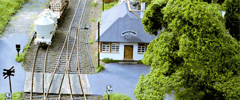Rules
- Proper technical condition and smooth running.
- Wheels according to NEM 310.
Lower flanges are permitted as long as a save operation is not harmed. (see also: "Best practices") - Operational standard-N-coupler (see also: NEM 356) on both sides
(This does not apply to secondary vehicles and vehicles, which are equipped with another coupler in origin also.) - All vehicles can, also as a train set, pass curved tracks with minimum 0.45m radius.
- The clearance is conform to NEM 302.
- Lights – and other additional equipment – is applicable for 14,5V ( Top value equals to effective value)
- Clear owner label, in order that all vehicles will "find home" at the end of the meeting.
Recommendations
- To improve the safety against derailing, especially of inhomogeneous, long or pushed trains, the mass of all cars is increased to unified 7.5 g per a axis. Removable freights are allowed to add additional 30%.
- Lights and electrical head and tail-lights preferably can be digitally switched off.
- Cards for cars and locomotives (see the following pages) are created with unified tools, preferably with FreDL (see also: "Best practices").
Best Practices
Vehicles with bogies or with 3-point-bearing or comparable construction get along with 0.5 mm flange's height on accurate laid track; any lower flanges are not advised.
Originally, a spring holds the clamp of the N-coupler in horizontal position. Vehicles couples smoother if the clamp falls back only by the force of gravitation because the spring was disabled. Longer test showed no disadvantages on proper laid tracks. The modification of newer vehicles (with NEM slot, or such like) is easy, modifications of older vehicles may be more complicated. Compatibility rules apply.
is not only appropriate for creating car cards, but also especially for the administration of the whole rolling stock [and a lot of other equipment] and therefor makes the organization of meetings more easy.


